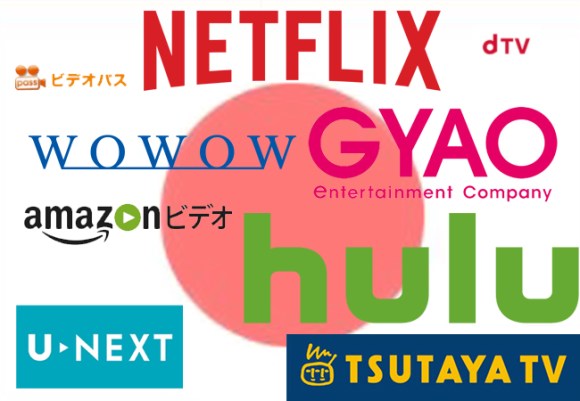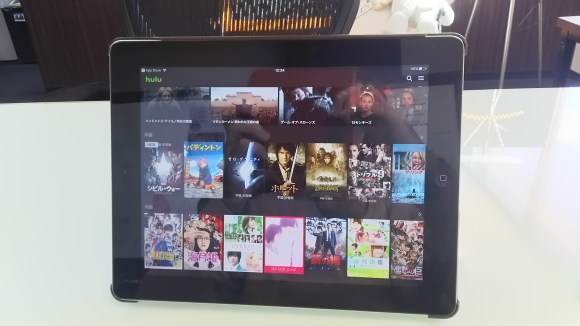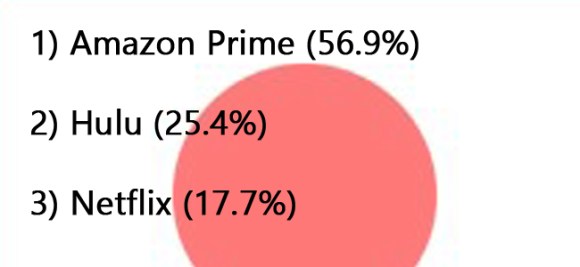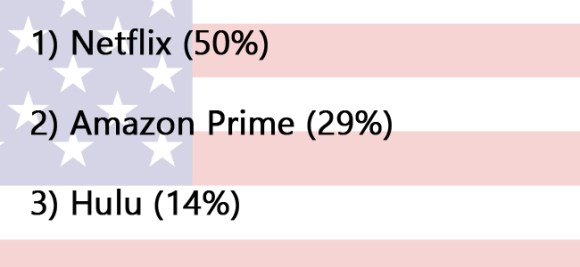
In the relatively new market of video services in Japan, one clearly stands above the rest. But you might be surprised what it is.
It’s been a long time coming, but Japan has finally embraced subscription-based video streaming services. While video rental stores had already been wiped clear off the map in many other countries, they seemed to have a tenacious presence in Japan, and a few of the remaining major chains can still be found relatively easily today.
▼ With its living and breathing video rental stores,
a visit to Japan can be like visiting Colonial Williamsburg
But with Netflix’s entrance to the Japanese market in September of 2015, the race has finally gotten into full swing. According to a report by Marketing Research Camp, 16.5 percent of Japanese residents use these services. The way in which this pales to the 53 percent usage in the USA should show how far behind we still are though.
So with this new market burgeoning, many contenders have come out of the woodwork. Hulu got a huge head start in Japan, launching way back in 2011. But it hasn’t been as aggressive as Netflix and suffered a few set backs last year when the company changed hands, including a very unpopular new interface.
▼ Hulu Japan boasts over 40,000 titles. Damned if I can figure
out how to find where most of them are though.
Video rental giant Tsutaya has also ventured into the streaming business but hasn’t really seemed to attack it with the same gusto that they had with physical rentals. And then there’s a whole slew of services from Japanese telecom companies like SoftBank and J:Com, some with amusingly hard-to-pronounce names.
▼ “Me? Nah, I’m just gonna WOWOW, GYAO, n’ chill tonight.”
And who among all these competitors is on top? Let’s look at the ranking:
In Japan, Amazon Prime Video is by far the most used video streaming service, which is mind-boggling to me because after signing up for a trail version, I quit after about ten minutes. Its selection and options were rather limited, and I was even asked to pay additional fees to watch certain titles.
The situation in Japan is nearly the opposite of the situation in the U.S. according to data from Statista:
If I had to venture a guess, I’d say that Amazon Japan is having an all too easy time reeling in pre-existing Amazon users. And given Japan’s overall on-demand video naiveté, people probably just assume the others are more or less the same and stick with it.
The Japanese standings of Hulu and Netflix likely largely boil down to timing. Netflix has made a fairly wide advertising campaign, and yet when those who do not subscribe to any service were asked which company they’d consider, Netflix could only get 23.6 percent of people compared to Hulu’s 33.3 percent and Amazon’s 30.6 percent. Hulu simply seems more entrenched in the Japanese consciousness at this point.
Here’s what those online had to say about it:
“Over 50 percent is pretty amazing.”
“Amazon’s line-up is pretty crappy and good titles get taken down quickly.”
“Hulu’s UI is garbage.”
“Definitely in terms of quality, Netflix is the best option.”
“The Japanese Netflix original shows are garbage.”
“It’s good to have choices, but all of them are just different levels of crap, so there isn’t a big difference. So I’d go with Prime.”
“I decided to throw away my TV rather than pay 1,500 a month to NHK. Amazon Prime for 500 yen is a way better option.”
“Half of the people use Amazon, that’s hilariously embarrassing.”
It would seem a majority of comments online are praising the quality of Netflix’s content, meaning that despite the numbers, positive word of mouth is spreading. If that momentum continues then we could see American-like figures in the near future.
Comments online regarding Hulu have been less than kind recently due to their amazingly unpopular update last year. However, that still could end up working in the company’s favor. At that time, Hulu Japan became an independent entity from the American one, meaning that they could focus more deeply on the Japanese market.
Netflix seems more about content for U.S. audiences, despite the Americanized Death Note ironically playing better with Japanese viewers. If Hulu can use their home-field advantage and dig up some attractive Japanese-oriented original content, they may win this yet. It’s still very early in the game, so anything can happen.
Source: President Online, My Game News Flash, Statista
Images: SoraNews24





 Hulu Japan to give all customers 1,000-yen apology for recent problems
Hulu Japan to give all customers 1,000-yen apology for recent problems Live-action Spirited Away stage play to stream online this summer
Live-action Spirited Away stage play to stream online this summer Netflix is launching a canned cocktail in Japan
Netflix is launching a canned cocktail in Japan Netflix creates otaku virtual YouTuber who’s a bilingual Japanese/English sheep girl【Videos】
Netflix creates otaku virtual YouTuber who’s a bilingual Japanese/English sheep girl【Videos】 Tokyo’s most famous video rental shop is shutting down
Tokyo’s most famous video rental shop is shutting down Non-tourist trap fish market in northeastern Japan captures our hearts with amazing sashimi
Non-tourist trap fish market in northeastern Japan captures our hearts with amazing sashimi Kyoto becomes City of Yokai, with Night Parade of One Hundred Demons festival this autumn
Kyoto becomes City of Yokai, with Night Parade of One Hundred Demons festival this autumn Japan’s newest life-size Gundam is finished, receives Shinto blessing in Osaka【Video】
Japan’s newest life-size Gundam is finished, receives Shinto blessing in Osaka【Video】 Chinese drivers flocking to Japan for quick and easy route to international licenses
Chinese drivers flocking to Japan for quick and easy route to international licenses One of Japan’s most awesome rail passes, the Seishun 18 Ticket, just got a lot less awesome
One of Japan’s most awesome rail passes, the Seishun 18 Ticket, just got a lot less awesome No train, no hotel – How to do an overnight bus trip to Kanazawa from Tokyo – Part 1【Photos】
No train, no hotel – How to do an overnight bus trip to Kanazawa from Tokyo – Part 1【Photos】 McDonald’s Japan debuts new anime girl mascot character with incredibly long name
McDonald’s Japan debuts new anime girl mascot character with incredibly long name Korean basketball coach humiliates player live on TV, tapes his mouth shut
Korean basketball coach humiliates player live on TV, tapes his mouth shut We try a delicious hidden gem in Fukuoka, unknown to even Japanese people
We try a delicious hidden gem in Fukuoka, unknown to even Japanese people Studio Ghibli releases new “Butterflies in the Forest” Totoro towels
Studio Ghibli releases new “Butterflies in the Forest” Totoro towels What’s the deal with akebi, the perfectly purple, alien-like fruit that’s in season now in Japan?
What’s the deal with akebi, the perfectly purple, alien-like fruit that’s in season now in Japan? Totoro, Calcifer, other Ghibli stars returning as humidifiers ahead of Japan’s dry winter days【Pics】
Totoro, Calcifer, other Ghibli stars returning as humidifiers ahead of Japan’s dry winter days【Pics】 Is downtown Tokyo’s crazy cheap 290-yen bento boxed lunch shop still around, and is it still cheap?
Is downtown Tokyo’s crazy cheap 290-yen bento boxed lunch shop still around, and is it still cheap? Meet the kind Japanese grandpa who takes photos for tourists at the Hachiko statue in Shibuya
Meet the kind Japanese grandpa who takes photos for tourists at the Hachiko statue in Shibuya Studio Ghibli releases new mug tumblers featuring anime movie characters
Studio Ghibli releases new mug tumblers featuring anime movie characters How to power up the coolest cheap souvenir from Nintendo’s official shop with a trip to Daiso
How to power up the coolest cheap souvenir from Nintendo’s official shop with a trip to Daiso Why was the Lithuanian ambassador to Japan working in a fast food beef bowl joint in Tokyo?
Why was the Lithuanian ambassador to Japan working in a fast food beef bowl joint in Tokyo? Line of foreign tourists leads us to Akihabara’s meatiest fatty ramen【Taste test】
Line of foreign tourists leads us to Akihabara’s meatiest fatty ramen【Taste test】 Japanese convenience store Family Mart announces abolishment of eat-in spaces
Japanese convenience store Family Mart announces abolishment of eat-in spaces Studio Ghibli releases new insect whistle necklace from Nausicaä of the Valley of the Wind
Studio Ghibli releases new insect whistle necklace from Nausicaä of the Valley of the Wind Totoro sequel anime Mei and the Baby Catbus will screen at Ghibli Park this winter
Totoro sequel anime Mei and the Baby Catbus will screen at Ghibli Park this winter Starbucks Japan unveils Halloween Frappuccino for 2024, and it’s like drinking a magic spell
Starbucks Japan unveils Halloween Frappuccino for 2024, and it’s like drinking a magic spell Evangelion creator Hideaki Anno returning to anime with new project for 50-year-old franchise
Evangelion creator Hideaki Anno returning to anime with new project for 50-year-old franchise Studio Ghibli releases new Howl’s Moving Castle goods that capture the magic from the anime movie
Studio Ghibli releases new Howl’s Moving Castle goods that capture the magic from the anime movie Adult Jam Bread causes a stir at store in Tokyo
Adult Jam Bread causes a stir at store in Tokyo Right now is the peak time to go to Tokyo’s most-beautiful-view beer garden【Photos】
Right now is the peak time to go to Tokyo’s most-beautiful-view beer garden【Photos】 Pizza Hut adds a “Guilty Secret” sandwich to its menu for a limited time
Pizza Hut adds a “Guilty Secret” sandwich to its menu for a limited time McDonald’s new Happy Meals offer up cute and practical Sanrio lifestyle goods
McDonald’s new Happy Meals offer up cute and practical Sanrio lifestyle goods Foreign tourists on Shinkansen bullet train break suitcase etiquette, angering local passengers
Foreign tourists on Shinkansen bullet train break suitcase etiquette, angering local passengers [Deleted] Article written for April Fool’s Day 2018
[Deleted] Article written for April Fool’s Day 2018 Japanese government to make first change to romanization spelling rules since the 1950s
Japanese government to make first change to romanization spelling rules since the 1950s Foreigner’s request for help in Tokyo makes us sad for the state of society
Foreigner’s request for help in Tokyo makes us sad for the state of society Ghibli founders Toshio Suzuki and Hayao Miyazaki contribute to Japanese whisky Totoro label design
Ghibli founders Toshio Suzuki and Hayao Miyazaki contribute to Japanese whisky Totoro label design Tokyo’s most famous Starbucks is closed
Tokyo’s most famous Starbucks is closed Princesses, fruits, and blacksmiths: Study reveals the 30 most unusual family names in Japan
Princesses, fruits, and blacksmiths: Study reveals the 30 most unusual family names in Japan Doraemon found buried at sea as scene from 1993 anime becomes real life【Photos】
Doraemon found buried at sea as scene from 1993 anime becomes real life【Photos】 Over 94 percent of Japanese people in survey find movie theater prices too expensive
Over 94 percent of Japanese people in survey find movie theater prices too expensive Bulky boxes of wagyu beef can be yours with Japan’s rental frying pan/meat subscription service
Bulky boxes of wagyu beef can be yours with Japan’s rental frying pan/meat subscription service Netflix’s live-action One Piece shows off massive ships and sets in preview video【Video】
Netflix’s live-action One Piece shows off massive ships and sets in preview video【Video】 Amazon strikes down its Anime Strike video streaming service just before its first birthday
Amazon strikes down its Anime Strike video streaming service just before its first birthday Old Enough: Netflix show sparks global debate on parenting and child safety
Old Enough: Netflix show sparks global debate on parenting and child safety Last One Standing brings an entirely new kind of Japanese crime comedy to Netflix
Last One Standing brings an entirely new kind of Japanese crime comedy to Netflix The Simpsons Halloween episode pays tribute to popular anime
The Simpsons Halloween episode pays tribute to popular anime Stranger Things fails to overtake Spy X Family on Netflix Japan
Stranger Things fails to overtake Spy X Family on Netflix Japan Netflix producing stop-motion Pokémon series, stars human concierge at resort for Pokémon【Video】
Netflix producing stop-motion Pokémon series, stars human concierge at resort for Pokémon【Video】 Amazon Japan suddenly begins shipping video games overseas
Amazon Japan suddenly begins shipping video games overseas Nintendo aims for 3D animation of its characters to enter film business
Nintendo aims for 3D animation of its characters to enter film business Sanrio’s Gudetama is getting a Netflix series…that’s live-action??
Sanrio’s Gudetama is getting a Netflix series…that’s live-action?? Sonic the Hedgehog getting a new CG Netflix series produced in the U.S. and Canada
Sonic the Hedgehog getting a new CG Netflix series produced in the U.S. and Canada Japanese designer creates dream sneakers that everyone wants to buy
Japanese designer creates dream sneakers that everyone wants to buy More than one in three Japanese working women in survey would rather be housewives
More than one in three Japanese working women in survey would rather be housewives
Leave a Reply